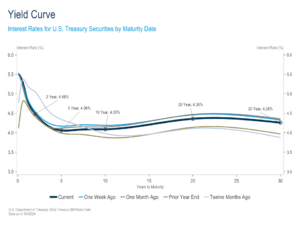Weekly Market Insights 03.11.24
Are We Seeing the Long-Awaited Rotation?
Financial Markets
United States equity markets took a pause from their remarkable run this past week. The Dow Industrials closed the week down 0.93%, the S&P 500 closed down 0.26%, while the NASDAQ ended the week down 1.17%. Last week’s pause makes sense given some of the comments we heard from Fed officials. Notably, Chairman Powell tempered hopes for an imminent rate cut, and, separately, Atlanta Fed President Bostic suggested that the Federal Reserve is under no urgent pressure to cut rates given the strength of the United States economy. Importantly, neither official ruled out rate cuts later on this year. They just pushed back against the need for immediate cuts beginning at their meeting next week.
Certainly, the most interesting market news is the nascent discussion about a possible rotation away from mega-cap tech stocks, and, more specifically, the Magnificent Seven—Apple, Microsoft, Alphabet, Amazon, Nvidia, Tesla, and Meta. These stocks have, in large part, driven the impressive performance of cap-weighted market indexes like the S&P 500 and the NASDAQ throughout 2023 and 2024.
While the rationale for a rotation away from these names may be strong, timing market movements is always shaky. We have made these points in this paper a number of times. Although quite early, the performance differential between the Magnificent Seven and the remaining stocks in the S&P 500 is beginning to narrow. Perhaps, more important than narrowing equity prices is narrowing earnings growth differentials. Why should this happen? One reason, of course, is the continued progression of the business cycle. The U.S. economy continues to be robust, showing no signs of weakening. Continued economic strength would be a greater benefit to the “average” companies that depend more on GDP growth for earnings. The next is an argument we have been making for a while. We have been calling it the New Industrial Revolution. It has to do with AI and all of the technological breakthroughs over the last two decades. All of that intellectual capital is now being integrated into industrial America—the capital for labor swap. This, along with the remarkable advances in medicine, will start to show up in the form of earnings. The really interesting thing about the capital for labor exchange is that it accomplishes four seemingly contradictory things: lowers costs, higher wages, increased productivity, and larger profits.
There are certainly potential headwinds to consider for investors. Rotations are often accompanied by corrections, and, in the midst of a correction, the fear is always that it will turn in to a bear market. How does one differentiate between a correction and bear market in the moment? There is no foolproof way. In our view, the best approach is to focus on economic fundamentals. A true bear market is unlikely to occur with a healthy economy.
Economics
We touched on the underlying strength of the United States economy in the Financial Markets section, but a quick recap is deserved. The U.S. economy is showing every sign that growth should continue. As we have written many times, the consumer represents about 70% of the economy. Having said that, job creations and wage growth are vital, and both are doing well. The Fed, a vital element in the health of the economy, is continuing to fine tune monetary policy. While the Fed’s current stance is if not easy, it most certainly is not tight. The Federal Reserve’s preferred inflation gauge, the Personal Consumption Expenditures Index (PCE), decelerated from an annualized 2.6% in December to 2.4% in January. GDP for 4th quarter 2023 grew at 3.2%, while the unemployment rate remains low at 3.9%. At the moment, the United States is the leading economy relative to global peers.
China opened its annual National People’s Congress this past week. Li Qiang, the Premier and second highest ranking official, opened the meeting, announcing several very ambitious goals for 2024. His goals included 5% growth and 3% consumer inflation. These are very ambitious targets considering the laundry list of challenges China is currently facing. Deflation, high youth unemployment, and low consumer confidence top the list, not to mention its much ballyhooed Belt and Road initiative, which continues to lose money. Premier Li never mentioned these problems nor any stimulus programs that could help to reignite the Chinese economy. It appears to us that China’s economy is not destined for a successful 2024.
The European Central Bank held rates steady at their meeting this past Thursday. Although inflation is headed in the right direction, it remains higher than desired. The E.U. Consumer Price Index for February was 2.6%, down from 2.8% in January but still above their 2% target. On a positive note, we wrote last week about Germany’s low industrial production, and, this week, the numbers turned up—quite a positive for both Germany and the European Union.
Conclusion
Our conclusion is a relatively bright one. The United States remains an attractive equity market globally, and the economy continues to be quite strong. Although improving, the U.K. remains a solid second choice. There may be an interesting investment opportunity in certain emerging markets, such as Vietnam and Malaysia, that may be taking advantage of China’s difficulties. Our thoughts on the potential for a market rotation may be early, but we are following it carefully. Broadened market performance may not be a bad thing.

Read pdf here.